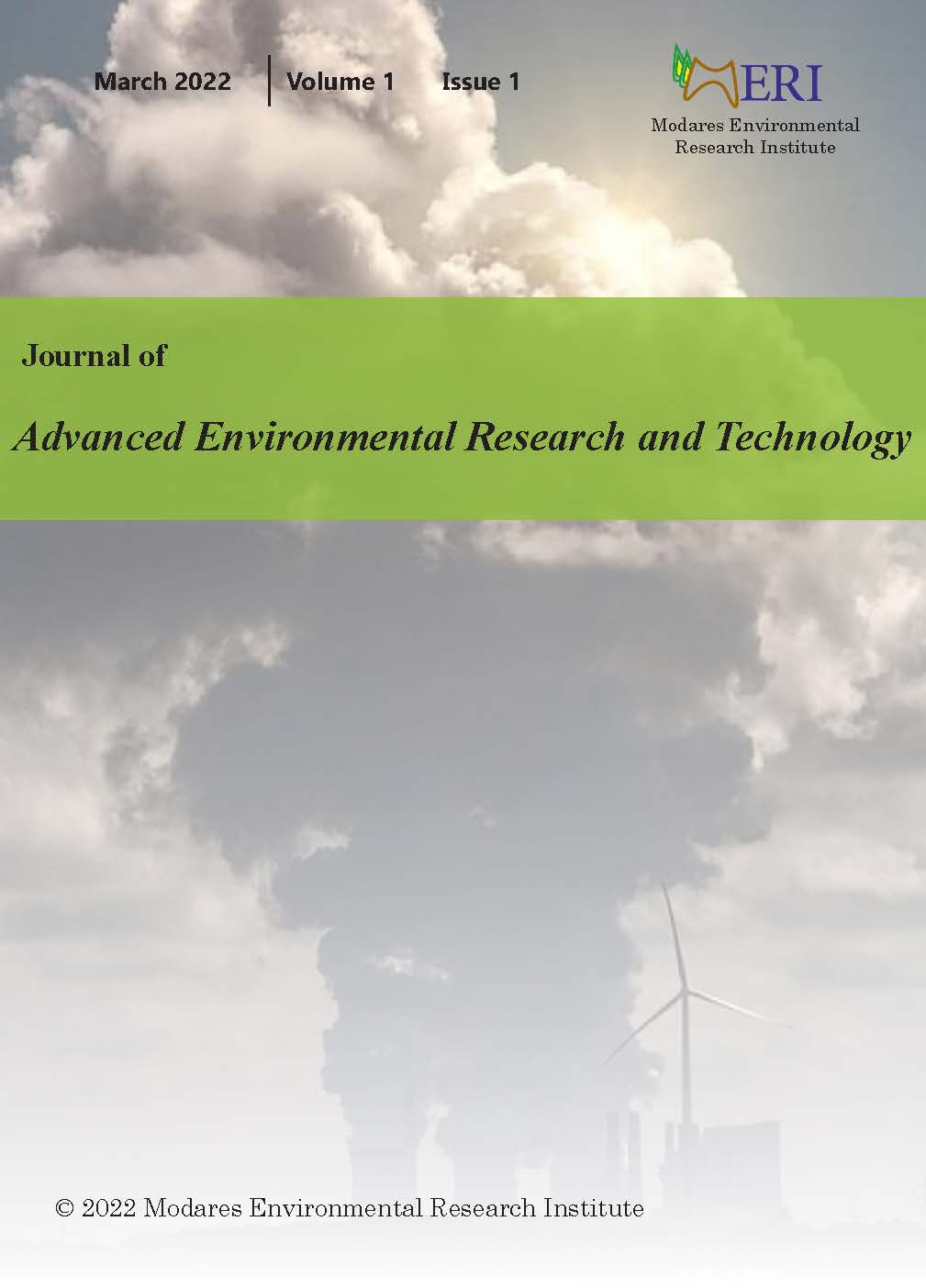
:pISSN
2981-1856 :eISSN
Journal of Advanced Environmental Research and Technology
- Editor-in-Chief: Seyyed Mohammad Mousavi
- Manager-in-Charge: Ahmad Jamshidi Zanjani
- Publisher: Tarbiat Modares University
- Journal Type: Scientific
- Publication Period: Quarterly
- Access Policy: Open
- Publication Format: Electronic
The quarterly Journal of Advanced Environmental Research and Technology is an OPEN ACCESS, peer reviewed, international and interdisciplinary journal on all aspects of monitoring, control and solutions to the pollutions in the environment. This includes chemical, physical and biological processes. The main aspects of research areas include, but are not exclusive to:
- Air quality and pollution control
- Water and wastewater quality and treatment processes
- Environmental pollution control technologies
- Waste minimization and management
- Solid waste recycling and reuse
- Soil biodegradation and bioremediation of contaminated sites
- Treatment and resource recovery
- Composting
- Leachate control and treatment
- Environmental pollution impacts on environment and human health
- Monitoring of environmental and industrial pollutants
- Health and ecological risk assessment of environmental and industrial pollutants
- Source identification and apportionment of environmental and industrial pollutants
- Fate of environmental and industrial pollutants
- All aspects of emerging contaminants in environment
The peer review process in This Journal is double-blinded in which the reviewer’s name is unknown to the author and, vice versa.
Submitted articles go through a structural and subject evaluation to align with Political Organizing of Space principles. Matches go through a double-blind peer review by three field experts (non-editorial staff) chosen by the Board based on specialty.The Board makes the final article selection.
Duties of Reviewers:
- Assist editor in decision-making and potentially help authors improve papers through editorial communication.
- Decline reviews if unqualified or unable to promptly review.
- Treat manuscripts as confidential documents and avoid unauthorized sharing.
- Conduct objective reviews, avoiding personal criticism and providing clear, supported feedback.
- Identify relevant, uncited published work and report potential plagiarism or overlap with other publications.
- Maintain confidentiality of information and ideas, avoiding personal gain or reviewing papers with conflicts of interest.
Open Access Policy: This Journal contents and the individual articles are freely available to readers without subscriptions or payments through the journal website or its permanent repositories.
This open-access journal is published under the terms of the Creative Commons Attribution-NonCommercial 4.0 International License which permits Share (copy and redistribute the material in any medium or format) and Adapt (remix, transform, and build upon the material) under the Attribution-NonCommercial terms.
Licensing Policy :This Journal is licensed under the terms of the Creative Commons Attribution-NonCommercial "(CC BY-NC)" This license lets others remix, tweak, and build upon your work non-commercially, and although their new works must also acknowledge you and be non-commercial, they don’t have to license their derivative works on the same terms.
View License Deed | View Legal Code
-
The Effect of Export Quality, Energy Efficiency, and Economic Complexity on CO2 Emissions in the Emerging Economies: A DEA Model and Quantile Regression
fariba osmani, Zahra Shirzour Aliabadi, Emad Kazemzadeh, Mohammad Taher Ahmadai Shadmehri
-
Life Cycle Assessment (LCA) for Municipal Solid Waste Management in Iran: A Case Study URMIA Metropolis
-
Environmental consequences of technology and industrial agglomeration in emerging economies: Evidence from a MMQREG new approach
-
Global trends of the scientific literature on detergents: A bibliometric analysis during 2000-2022
-
Experimental study of consuming horse bedding for re-bedding and energy production in Tehran
Gholamreza Asadollahfardi, Atefeh Seilanian, Elham Mahmod Por
-
Financial development and environment: Evidence of consumption-based CO₂ emissions
-
Environmental effects of enhanced oil recovery methods
-
Simulation of magnetic separation process in wet low intensity magnetic separator using DPM-CFD Method
Mr Pouya Karimi,Dr Zahra Mansourpour,Dr Ahmad Khodadadi Darban
-
Uranium Extraction with Cyanex272 Coated Magnetic Nanoparticles
-
Improvement of petroleum contaminated clayey soil by carbon fiber polymeric composite and diatomic soil
Amin Falamaki, Saeed Zahmatkesh, Marzieh Mehravaran, Hadi Ghodrat
-
The leachate treatment system of combined O3 oxidation, and activated carbon adsorption
-
Investigation on Fluoride Concentration in Well Water and Its Health Implications: A Case Study of Gwagwalada, Gwagwalada Area Council, FCT, Abuja
Habeeb Solihu, Ismaeel Abdulraheem, Solomon Olakunle Bilewu, Adeniyi Ganiyu Adeogun
-
Removal of hexavalent chromium from ferrochrome dust effluent by chemical precipitation method
-
Electrochemical textile dye removal using steel wool as an extended electrode
-
Multidimensional Approach to Mitigating Flood Risks and Impact: A Case Study of Rice Farming in Nigeria
Dr Modupe Olufunmilayo Jimoha ,Dr Solomon Olakunle Bilewu,Dr Adeniyi Saheed Aremu,Dr Habeeb Solihu
-
Effect of existing pollutants in leachate on geotechnical parameters of soil emphasizing organic pollution
-
The Effect of Export Quality, Energy Efficiency, and Economic Complexity on CO2 Emissions in the Emerging Economies: A Two-step DEA Model and Panel Quantile Regression
-
-
Uranium Extraction with Cyanex272 Coated Magnetic Nanoparticles
-
Evaluation of Nigeria's Air Quality and COVID-19 Cases, Recovery, and Mortality Rates
Johnson Olusola, Adebola Shote, Moyosola Adeyemi, Adebisi Enochoghene, Isaac Oluwatimilehin
-
Removal of Cd(II) from water sources using low-cost materials, modified low-cost adsorbents: A review
-
A Compendious Review of Treatment Methods used for Cyanide Removal from Mineral Effluents
Ahmad Shahedi, Ahmad Jamshidi-Zanjani, Mehdi Homaee, Fariborz Taghipour
-
Laboratory contaminating bacteria of acidophilic extremophiles: Polymerase chain reaction (PCR) characterization
-
MULTIDIMENSIONAL APPROACH TO MITIGATING FLOOD RISKS AND IMPACT: A CASE STUDY OF RICE FARMING IN NIGERIA
Modupe Olufunmilayo Jimoh, Solomon Olakunle Bilewu, Adeniyi Saheed Aremu, Habeeb Solihu
-
Effects of inorganic leachate components on shear strength and mechanical properties of soil: Experimental, Optimization via Response Surface Method
Mohammad Reza Sabour, Abolfazl Hamedani, Ghorban Ali Dezvareh









